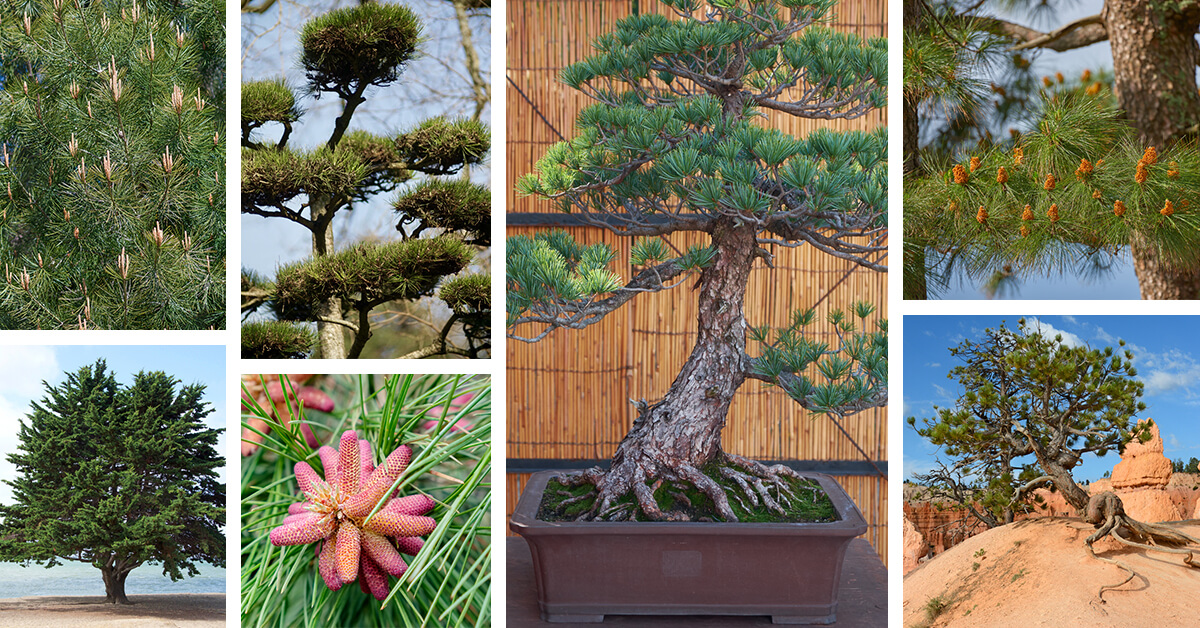There are well over a hundred different types of pine trees throughout the world. You’ll find them in cold regions, deciduous forests, and even hot, humid climates. Pine trees come in all shapes and sizes, depending on the environment and the type. In this article, we will look at some of the most common types of pine trees. Let’s get started!
Key Takeaways
- Pine trees are distinguishable by their needle-like leaves that grow in groups of 2 to 5.
- Pine seeds grow in seed cones, which can be long and narrow or egg-shaped.
- Most pine trees will grow in USDA growing zones 5 to 8, although some will grow in zones as cold as Zone 3 and up to Zone 11.
- Many pine trees can grow up to 100 feet tall or more.
- When landscaping, invasive or easily-naturalized trees should be avoided in favor of native trees.
38 Types of Pine Trees
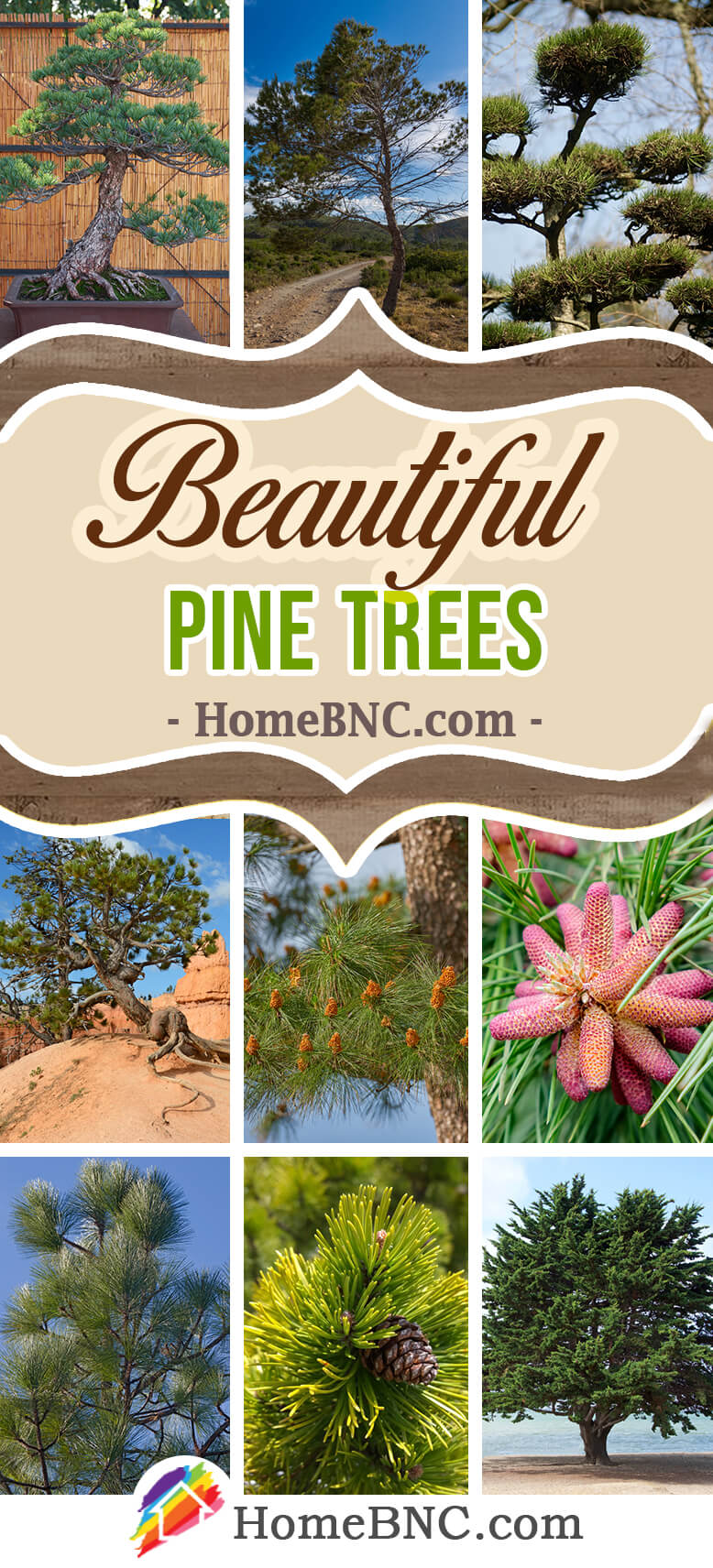
1. Aleppo Pine (Pinus halepensis)
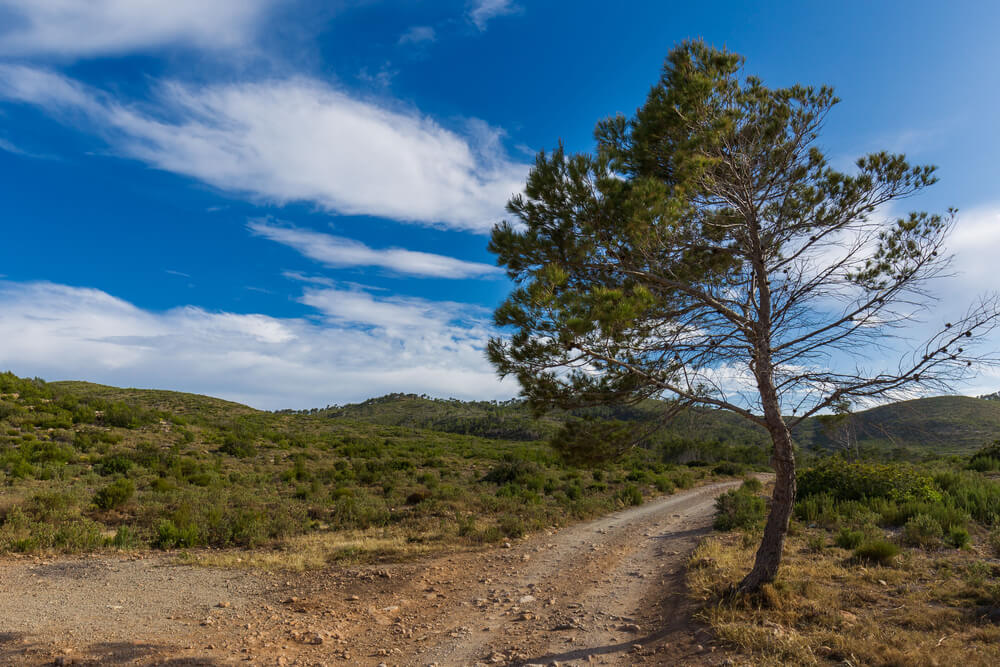
Also known as the Jerusalem pine, the Aleppo Pine is a highly invasive tree. It is known for being in the top five most invasive pine trees in the world. Its seeds are dispersed by the wind, and it can easily invade burned-out forests.
This medium-sized tree grows 30 to 65 feet tall. It can grow 15 to 20 feet wide. Its seed cones are 2 to 4.7 inches long and take up to 3 years to mature. It grows easily in USDA grow zones 8 – 11. The leaves are 2.4 to 5.9 inches long and are a greyish-green color.
2. Austrian Pine (Pinus nigra)
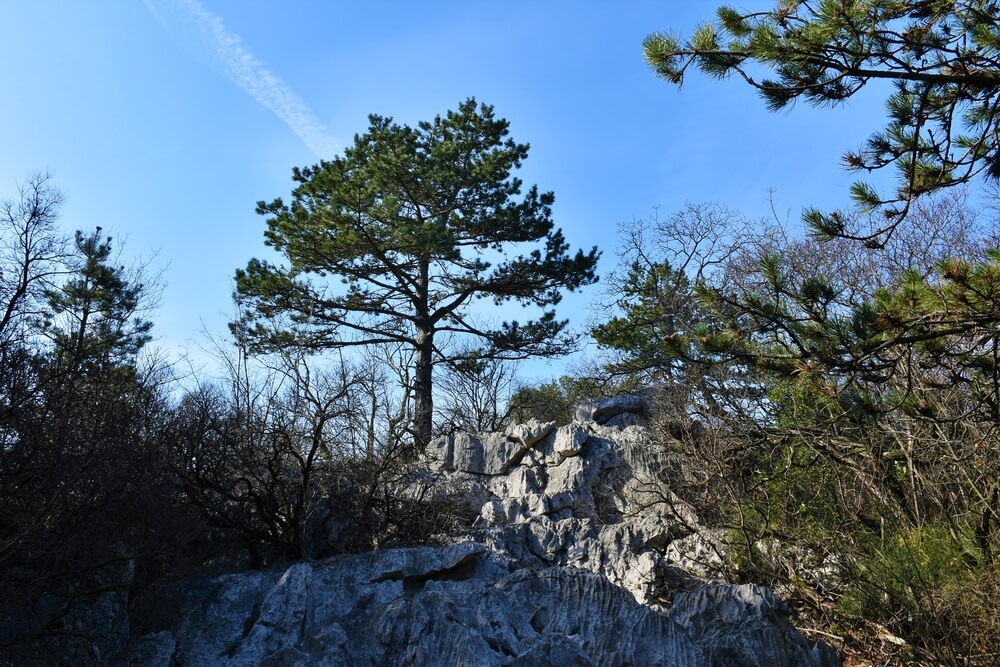
The Austrian Pine is not on the invasive species list. However, it naturalizes easily and has done so across North America. It is not native to the United States but will grow in USDA grow zones 5 – 8.
It grows 40 to 100 feet tall and 20 to 40 feet wide. It has several subspecies.
This tall pine tree has two leaves per fascicle, and they can be pale or dark green, stiff or pliant. The leaves grow anywhere from one and a half to seven and a half inches long. The tree has gray or brown bark with deep grooves.
3. Bristlecone Pine (Pinus aristata)
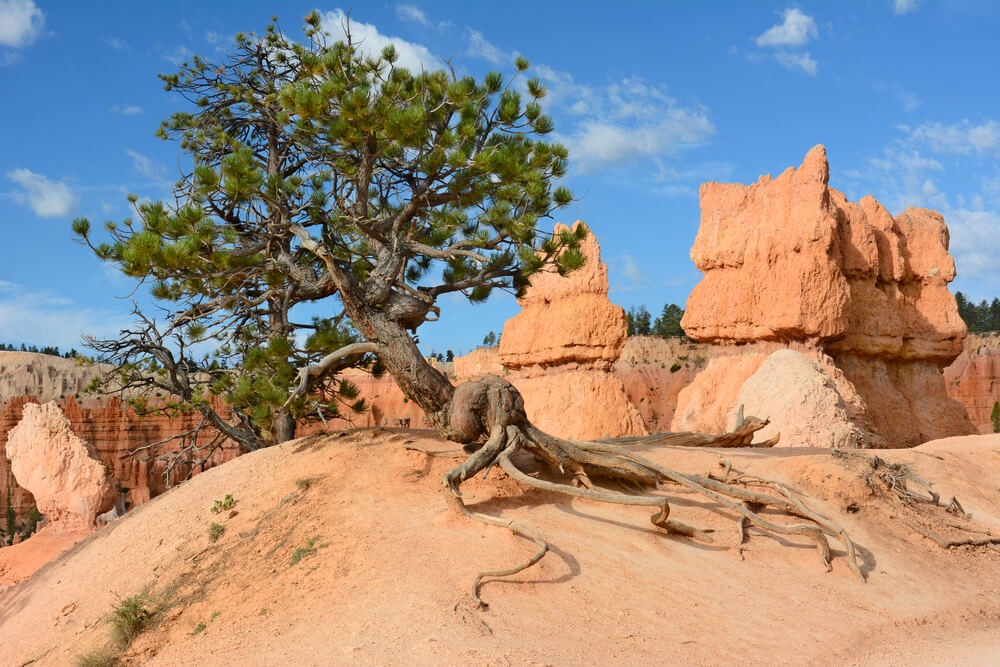
Also known as the Hickory Pine or the Rocky Mountain Bristlecone, the Bristlecone Pine is a shrubby tree with a twisty trunk and an irregular shape. It has showy gray to reddish-brown bark, one to one and a half inches long blue-green leaves that grow in groups of 5. Its cones are anywhere from 2.4 to 4.3 inches long. They’re prickly and egg-shaped when ripe.
You’ll find it in the Rocky Mountains of Colorado and down into Northern New Mexico, growing along tree lines in cold, dry climates. It can grow in USDA grow zones 3 to 7. When mature, it can be anywhere from 8 to 30 feet tall with a spread of 10 to 15 feet wide.
4. Canary Island Pine (Pinus canariensis)
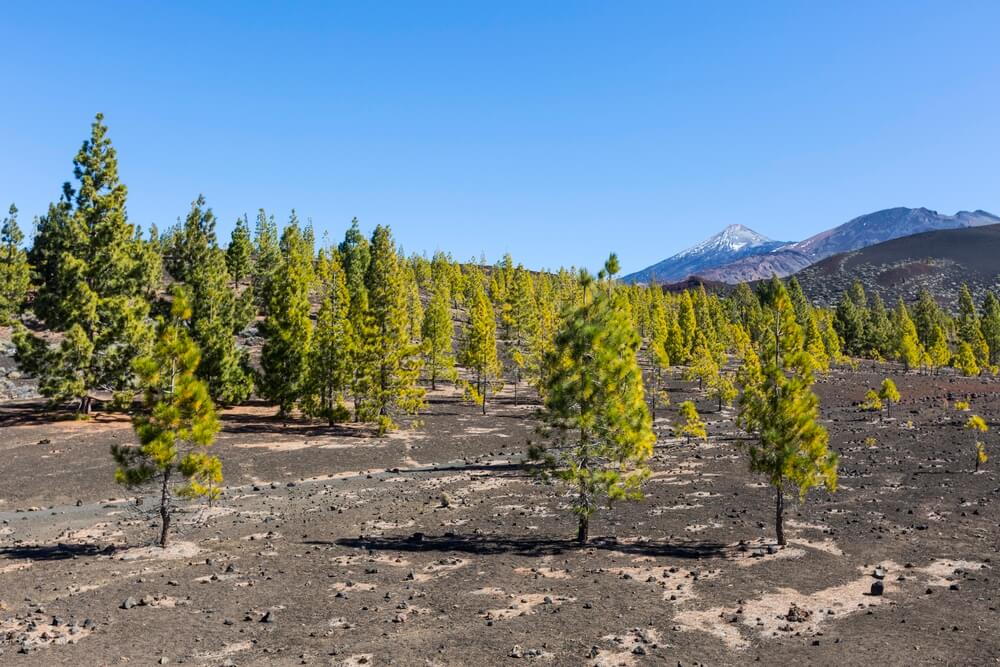
The Canary Island Pine gets its name because it is native to the Canary Islands. It is not invasive and has not naturalized in the United States. Commercially, it is typically cultivated for its timber.
The Canary Island Pine has a straight and tall trunk and bright green leaves. The leaves can grow up to 12 inches long, and the bark is thick, reddish-brown with light grooves. The seed cones can be up to 9 inches long.
This tree cannot tolerate cold climates, but it will grow well in most types of soil. It can grow in USDA growing zones 9 – 11. It can get up to 50 to 80 feet tall and 20 to 30 feet wide.
5. Chihuahuan White Pine (Pinus strobiformis)
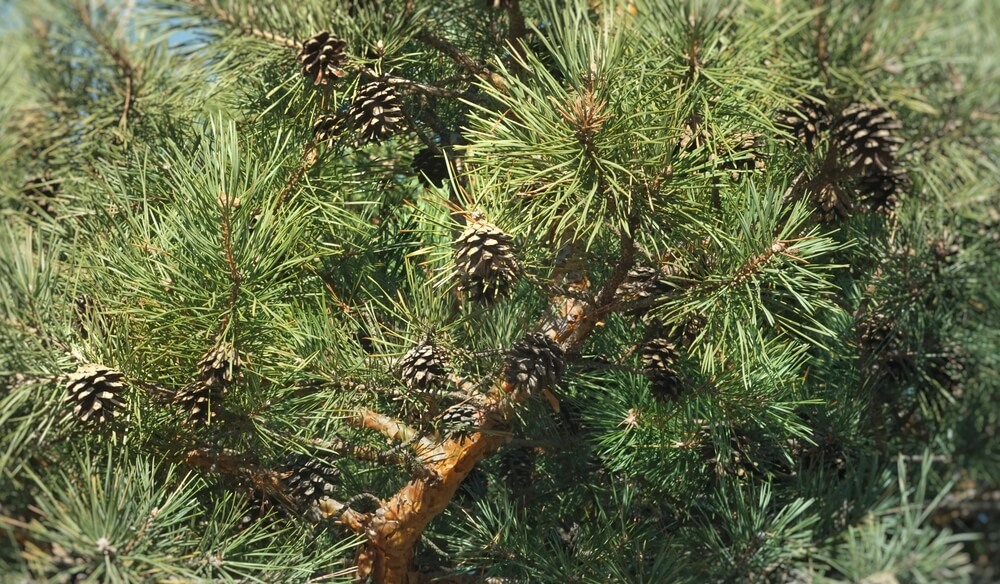
The Chihuahuan pine gets its name from its location – growing near Chihuahua, Mexico, and into the mountains of New Mexico and Arizona. It thrives in USDA Growing Zones 5 – 9, with a height of 80 to 100 feet tall at maturity, with a spread of 20 to 40 feet. It is easily confused with the Limber Pine and can hybridize with it.
It’s a straight and slender tree with small, blue-green, soft leaves growing in groups of 5. Its small cones are creamy-colored and grow up to 2.5 inches long. A variety of wildlife enjoys its seeds for food.
6. Chinese Red Pine (Pinus tabuliformis)
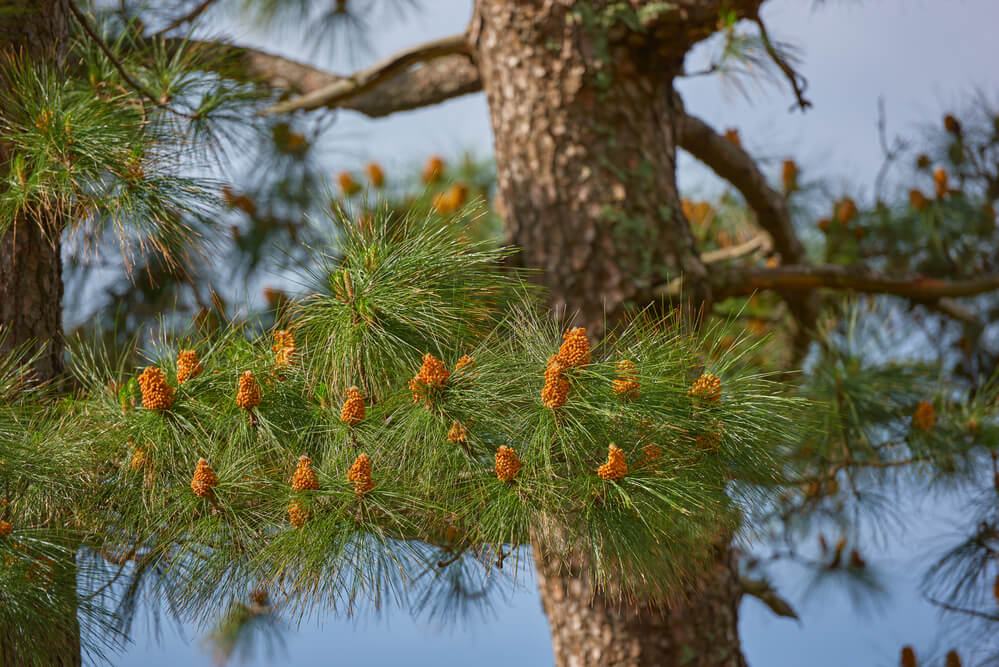
The Chinese Red Pine is a pretty landscaping tree that is not considered invasive. It can be used for lumber and as a Bonsai tree. It grows with grayish-brown bark and dark green leaves. The leaves are two to six inches long, with a soft feel. They grow in groups of two. The seed cones are typically egg-shaped at maturity and can last for a few years. The seeds are edible by wildlife and people.
The Chinese Red pine is native to Northern China and Northern Korea but can be grown in USDA grow zones 5 to 8. It will grow thirty to fifty feet tall and up to twenty feet wide.
7. Coulter Pine (Pinus coulteri)
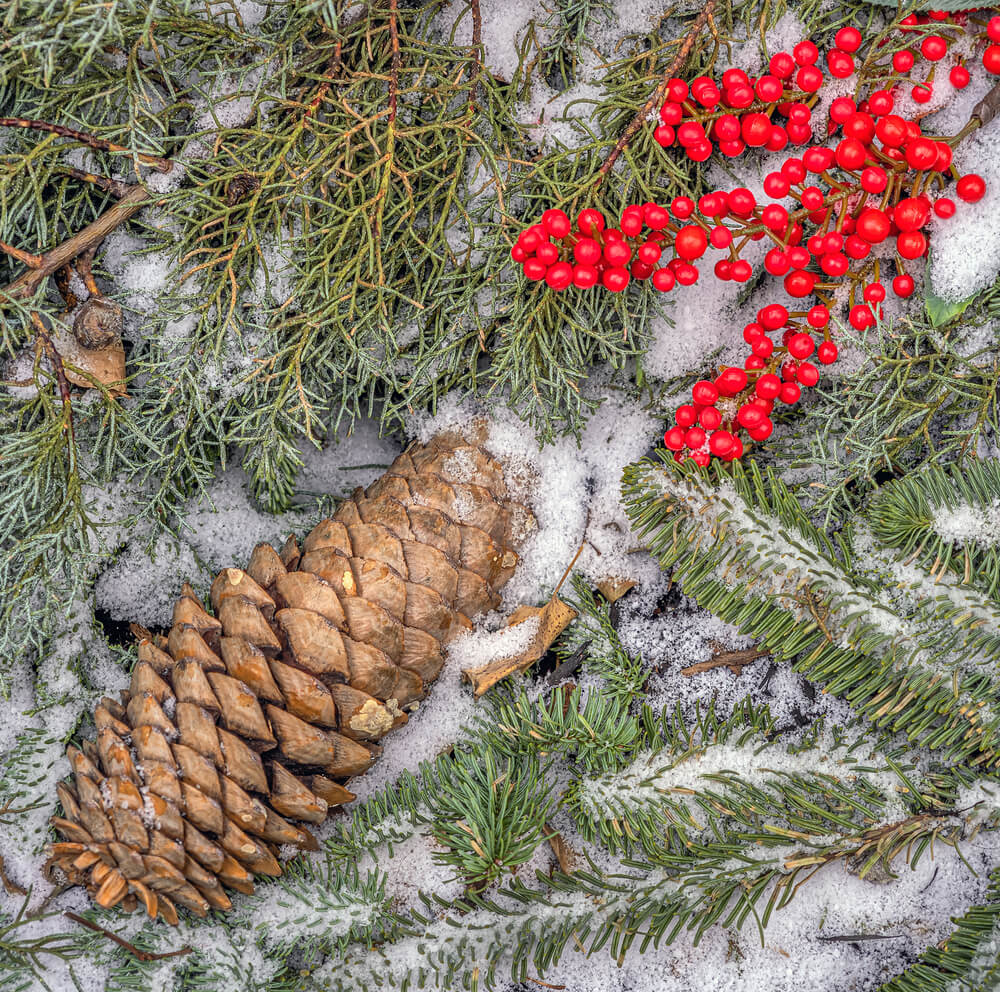
The Coulter Pine is unique because it has the heaviest seed cone in the world! The cone can weigh anywhere from 4.4 to 11 pounds when mature and are a favorite food among local wildlife. It’s also unique because it is a hardy and drought-tolerant tree used in landscaping in North America. In its natural habitat, it is considered to be near threatened. You’ll find it growing on the coastal mountains of California and down into Mexico.
It bears gray-brown bark that has deep grooves covering a straight or twisty trunk. It thrives in USDA growing zones 8 to 10. It can grow 30 to 75 feet tall and 20 to 30 feet wide.
8. Dwarf Mugo Pine (Pinus. Mug var pumilio)
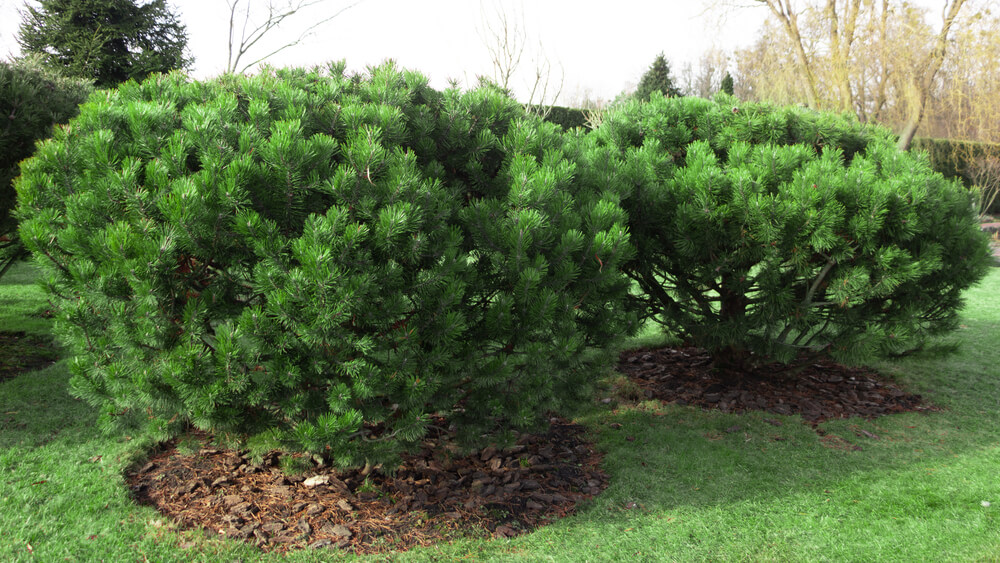
The Dwarf Mugo Pine is very similar to the Mugo Pine. However, it only grows to about five feet tall and six to ten feet wide. Due to its small stature, it has become popular for landscaping, even in small yards or gardens. It can tolerate a variety of soil types and pH but needs full sun with well-draining soil. The Dwarf Mugo pine is unlikely to become an invasive problem.
It is cold-hardy and shrub-like. Its leaves grow in an upward position. Sometimes, it is even used for Bonsai. The Mugo Pine is native to the mountains of central and Southern Europe and can be grown in USDA growing zones 3 through 7.
9. Eastern White Pine (pinus strobus)
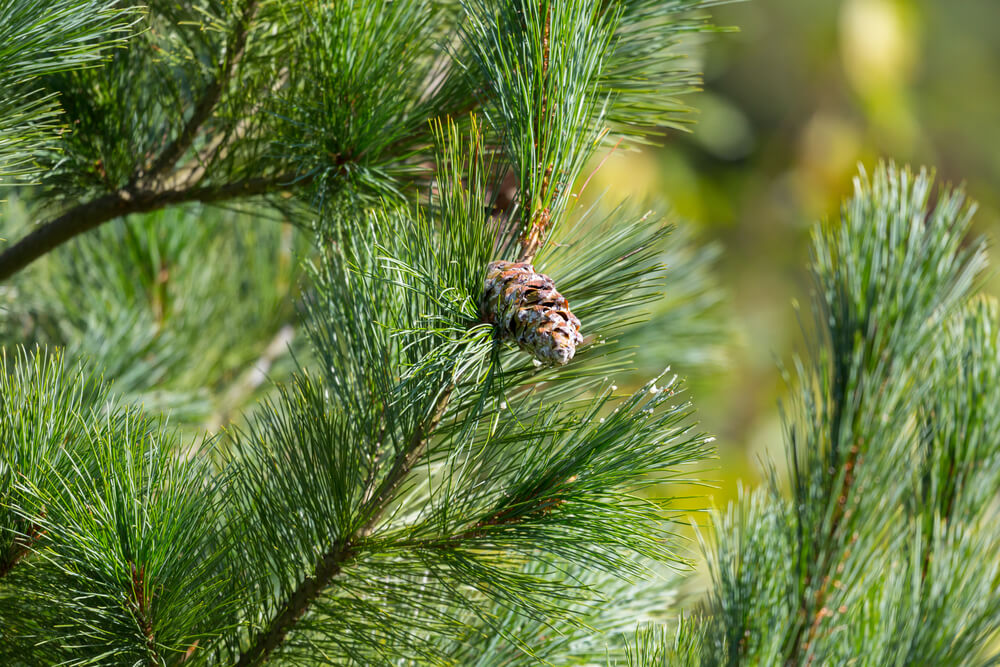
The Eastern White Pine has a well-defined Christmas tree shape.
The eastern White Pine is famous for its lumber, landscaping, and of course, as Christmas trees! You’ll find it growing in the northeastern United States, where it’s comfortable growing in USDA grow zones 4 – 9.
It will grow to 60 to 100 feet tall at maturity with a 20 to 40-foot spread.
It has grey-brown bark on a straight trunk. The leaves are green to blue-gray, growing about 2 to 4 inches long in groups of 5. Its seed cones can grow up to 8 inches long.
Logging has decimated natural white pine forests, leaving just 1 percent of the original population behind.
10. Eldarica Pine (Pinus brutia var eldarica)
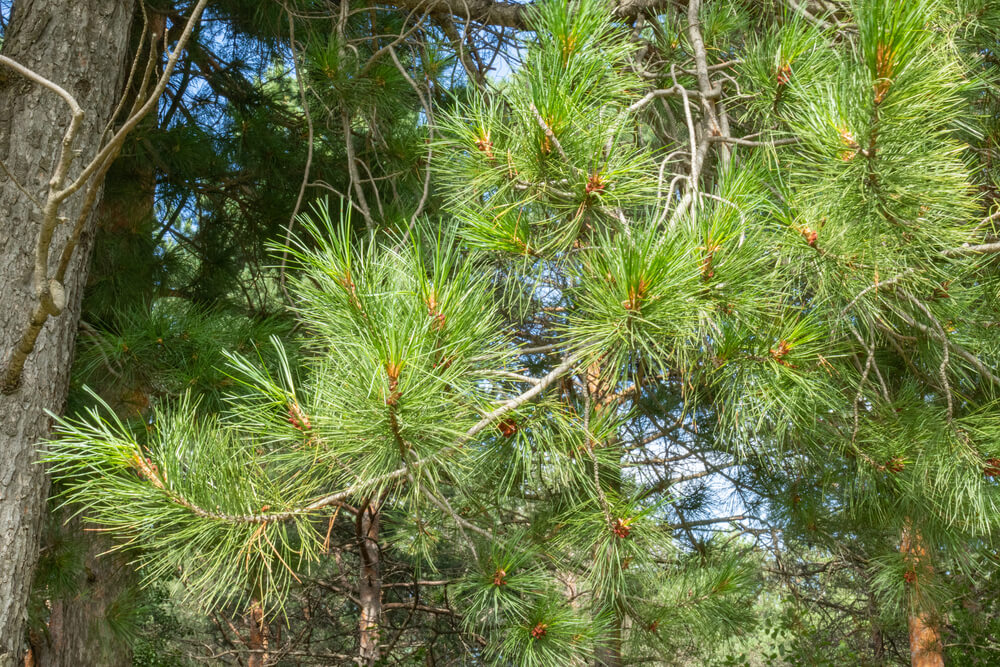
A mild controversy exists over Eldarica pine; it may be its own species. However, many authorities believe it is a subspecies of the Turkish pine. While it is similar to the Turkish pine, it is also more dense and upright and more heat, wind, and drought tolerant. The Eladrica pine makes a popular landscaping tree in desert states in growing zones 6 to 10. It will grow 30 to 80 feet tall and 15 to 30 feet wide.
It has 3 to 6-inch long leaves that grow in groups of two. Its seed cones range from two to 3 and a half inches long and are a favorite food among wildlife.
11. French Dark Green Scots Pine (Pinus sylvestris French Dark Green)
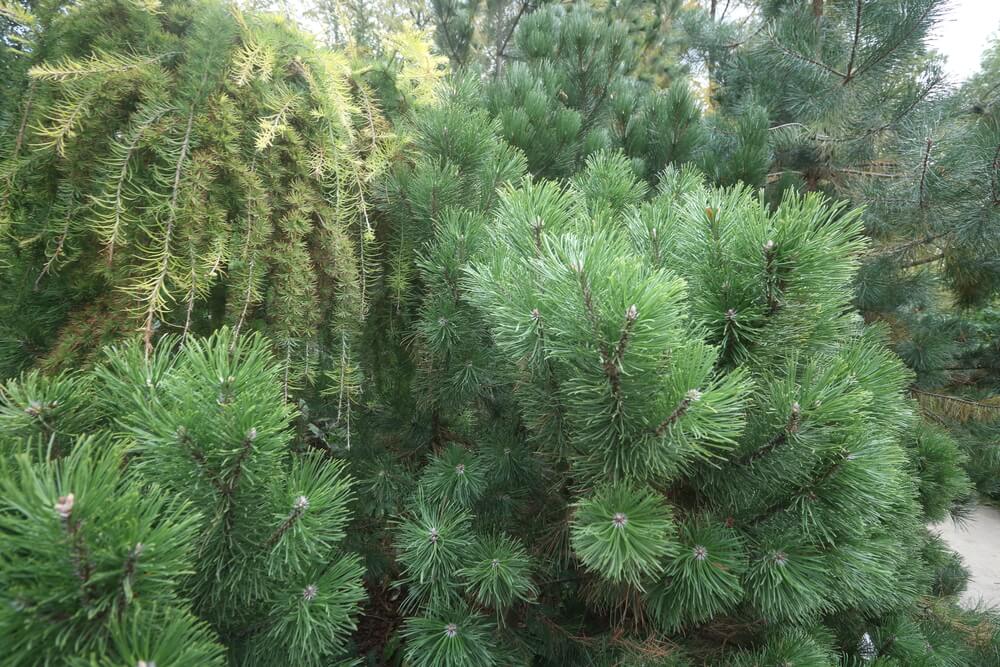
The French Dark Green Scots Pine is very similar to the Scots Pine. It has shorter, darker blue-green leaves. It has a red-brown-colored bark and a traditional Christmas tree appearance. It is also popular as a landscaping tree. It is less aggressive than the Scots Pine and very adaptable. It requires full sun to grow.
Because of its less-aggressive nature, it is a better choice as a landscaping plant than the original Scots Pine.
The French Dark Green Scots Pine can grow forty to fifty feet tall and anywhere from twenty to thirty-five feet wide. Therefore, it will grow easily in USDA growing zones 3 to 8.
12. Gray Pine (Pinus sabiniana)
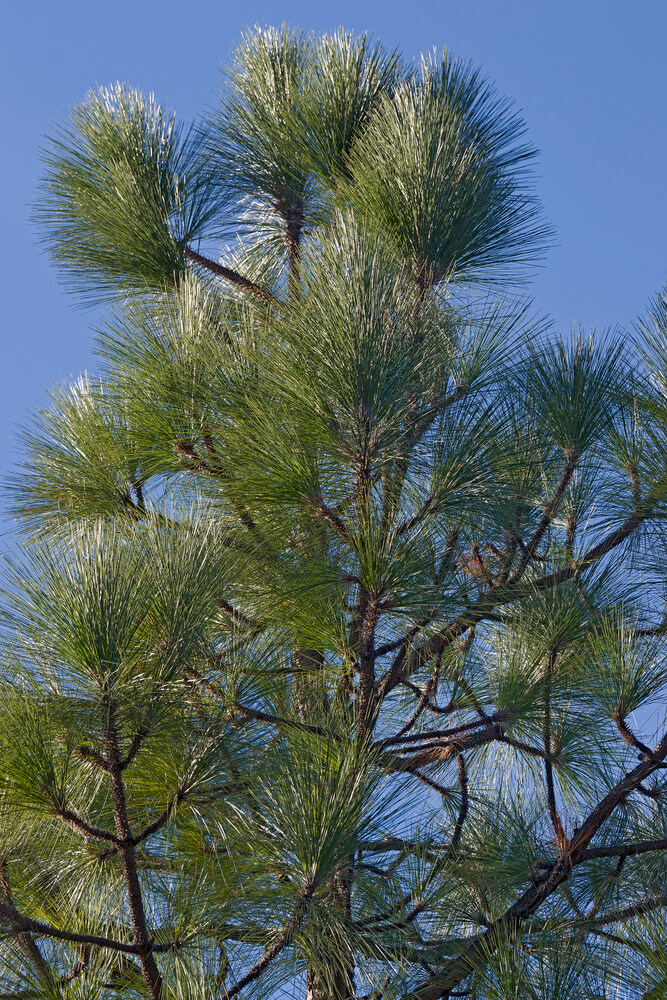
The Gray Pine is only endemic to the foothills of California and thrives in both full sun and part shade. However, the Gray Pine can easily grow in hot, dry locations with little water or irrigation. The crown may be cone-shaped or irregular, with dark brown or black grooved bark.
The leaves of the gray pine can grow up to 12 ½ inches long and are a muted blue-green. Its seed cones are egg-shaped or cylindrical. It can grow from 20 to 83 feet high and 20 to 40 feet wide at maturity. It can be found in USDA growing zones 8 to 10.
13. Jeffrey Pine (Pinus jeffreyi)
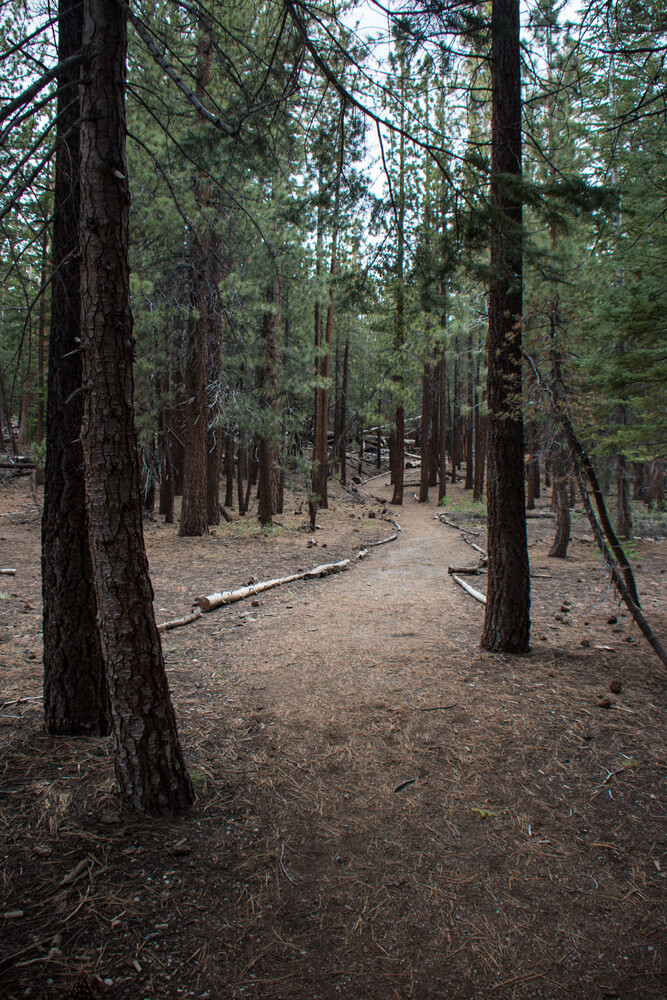
The Jeffrey Pine was named in honor of its discoverer, John Jeffrey, a Scottish 19th-century botanist who traveled in the western United States. It is tall and straight but somewhat sparse. Its bark is fragrant and smells like vanilla or butterscotch. Its leaves grow in groups of three and can be up to 10 inches long. It typically grows in the mountains at elevations of 1500 to 10,200 feet.
It grows naturally in the western United States, in California, Oregon, Nevada, and even Mexico, in zones 5 to 8. It will grow 80 to 140 feet tall, with a spread of 20 to 30 feet wide.
14. Japanese Black Pine (Pinus thunbergia)
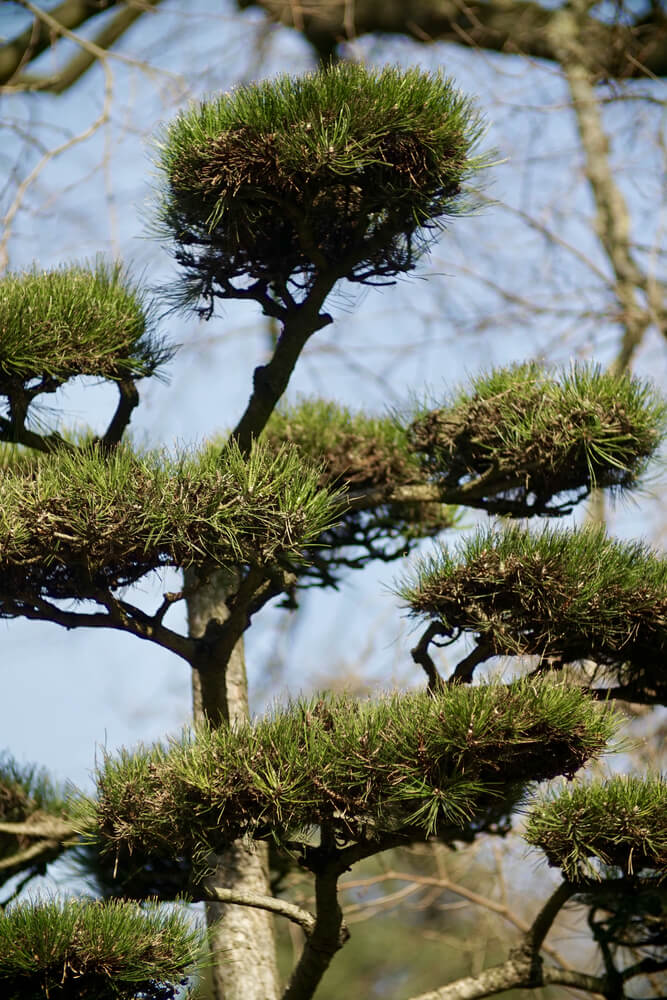
This tree originated from Japan and Korea but has naturalized in parts of the United States. And while it is a popular landscaping tree, it’s advisable to choose a native pine over this one when possible. It will grow in USDA grow zones 5 to 8.
It grows 20 to 60 feet tall, with a spread of 12 to 20 feet wide. It has a wide trunk that can grow up to 6.5 feet across. The Japanese Black Pine has dark-colored bark, which can turn nearly black as it matures. The leaves grow in groups of 2 and are 2.4 to 4.7 inches long. Seed cones are egg-shaped and grow in groups of 2 or 3 but they drop quickly are the seeds are released.
15. Japanese White Pine (Pinus parviflora)
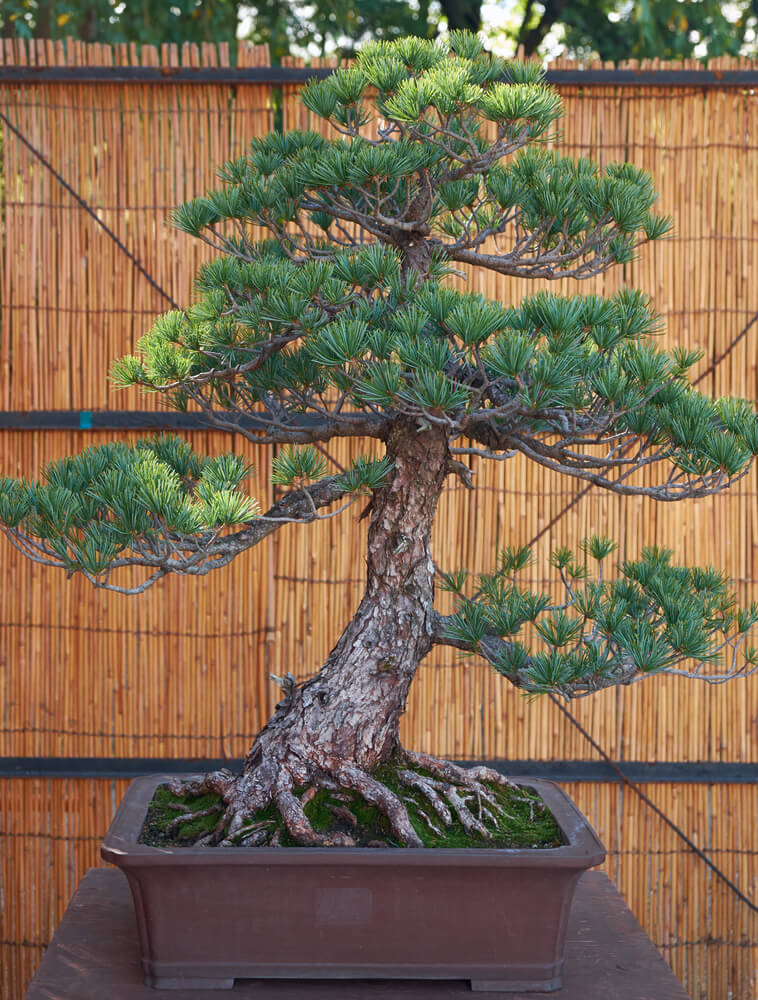
Another popular landscaping tree, the Japanese White Pine, is often used for Bonsai. It has attractive purple bark and blue foliage. The trunk can grow up to 3.3 feet across. It grows five leaves per group, and they are approximately 1 to 2 inches in length.
This pretty, medium-sized tree is easily confused with the Eastern White Pine, although the Japanese White Pine has shorter leaves and seed cones.
It will grow in USDA Growing zones 6 to 9 and is not invasive or naturalized. It will grow 20 to 50 feet tall and 25 to 50 feet wide.
16. Lacebark Pine (Pinus bungeana)
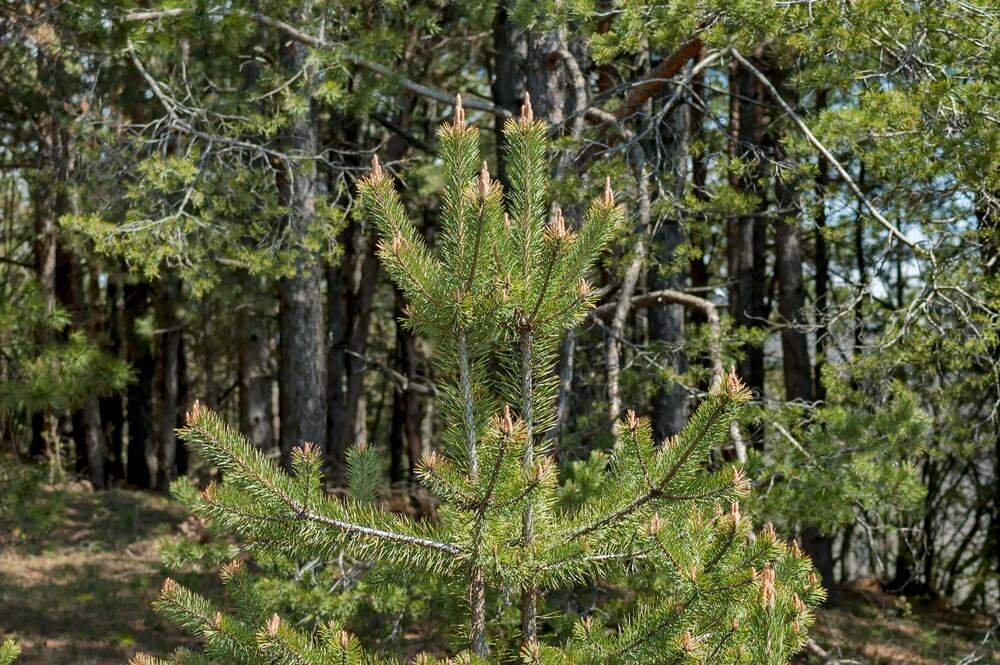
An easy tree to identify, the Lacebark Pine has multiple trunks with a paper-like bark that peels off in patches, creating a lacy or mottled appearance.
This is a very slow-growing pine that does not self-fertilize, so it is unlikely to naturalize or become invasive. Its leaves grow in groups of 3. They are rigid and can be anywhere from two to four inches long. In addition, it has small, individually growing seed cones.
The Lacebark Pine does not grow well in hot climates. It originated in Asia and will grow in USDA grow zones 4 – 7. It will grow 30 to 50 feet tall and 20 to 35 feet wide.
17. Limbar Pine (Pinus flexilis)
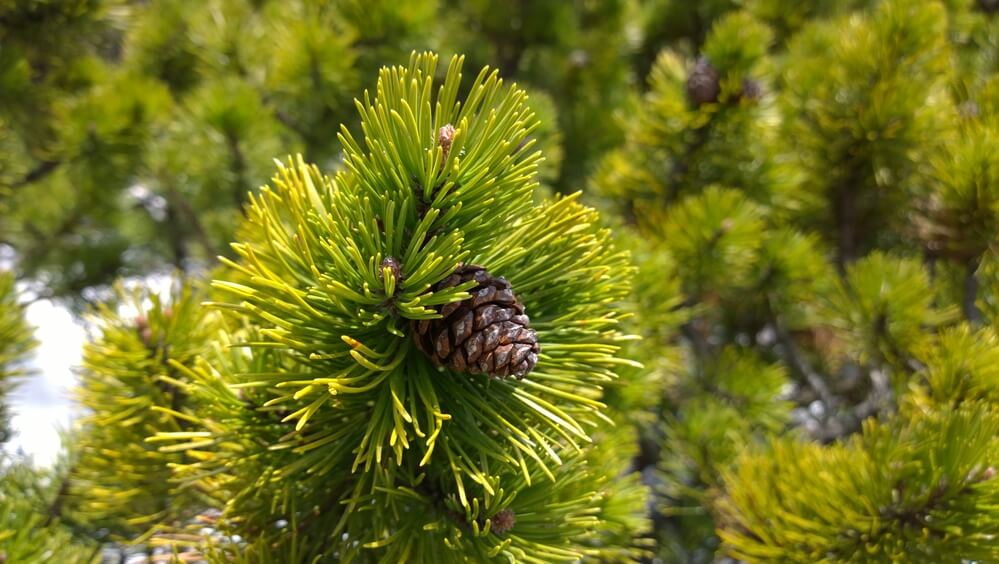
The Limbar Pine is an adaptable tree that can thrive even in poor soil. Its trunk can be straight or even a bit twisted. It can grow to over 6 feet in diameter with smooth gray bark. Its leaves grow in groups of 5 and are a dark green color, growing up to 2.75 inches long. It has narrow, egg-shaped cones.
You’ll find it growing naturally in the mountains of Southwest Canada through California and Arizona. It will grow in zones 4 to 7. At maturity, it will range in size from 20 to 50 feet tall and 10 to 30 feet wide.
18. Loblolly Pine (Pinus taeda)
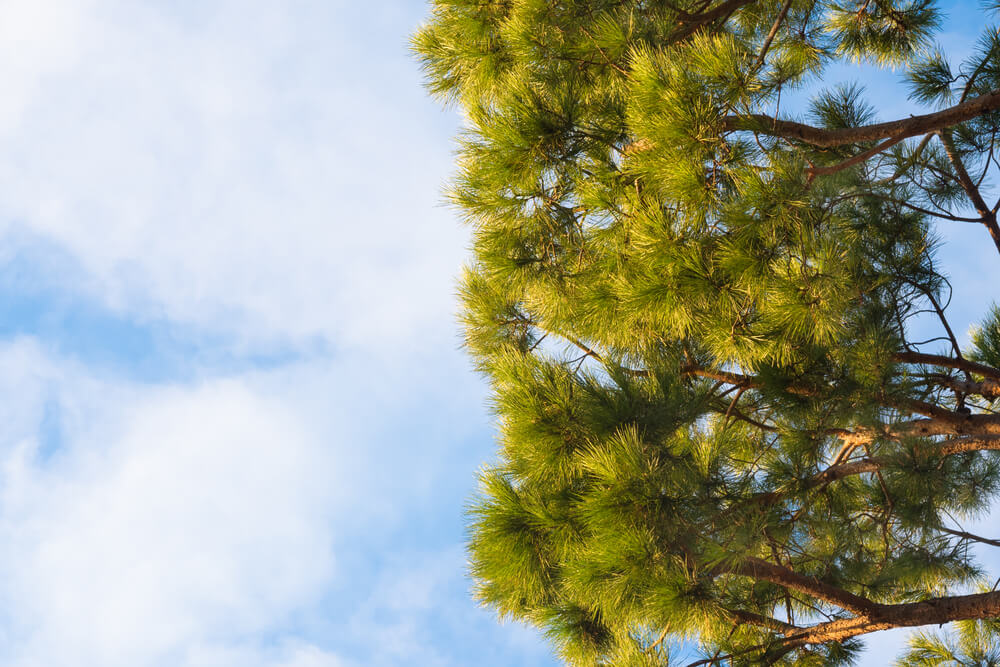
The Loblolly Pine grows in wet, swampy areas, making it perfect for growing in wet, soggy soil. This fast-growing pine tree boasts are very straight trunk. As it grows, the lower branches die off, making it look like it has a high crown.
It grows 4 to 9-inch long, yellow-green leaves in groups of three, contrasting beautifully with its reddish-brown bark. It grows 50 to 80 feet tall with a spread up to 35 feet wide. You’ll find it anywhere from New Jersey to Florida and as far west as Texas in USDA grow zones 6 through 9.
19. Lodgepole Pine (Pinus contorta)
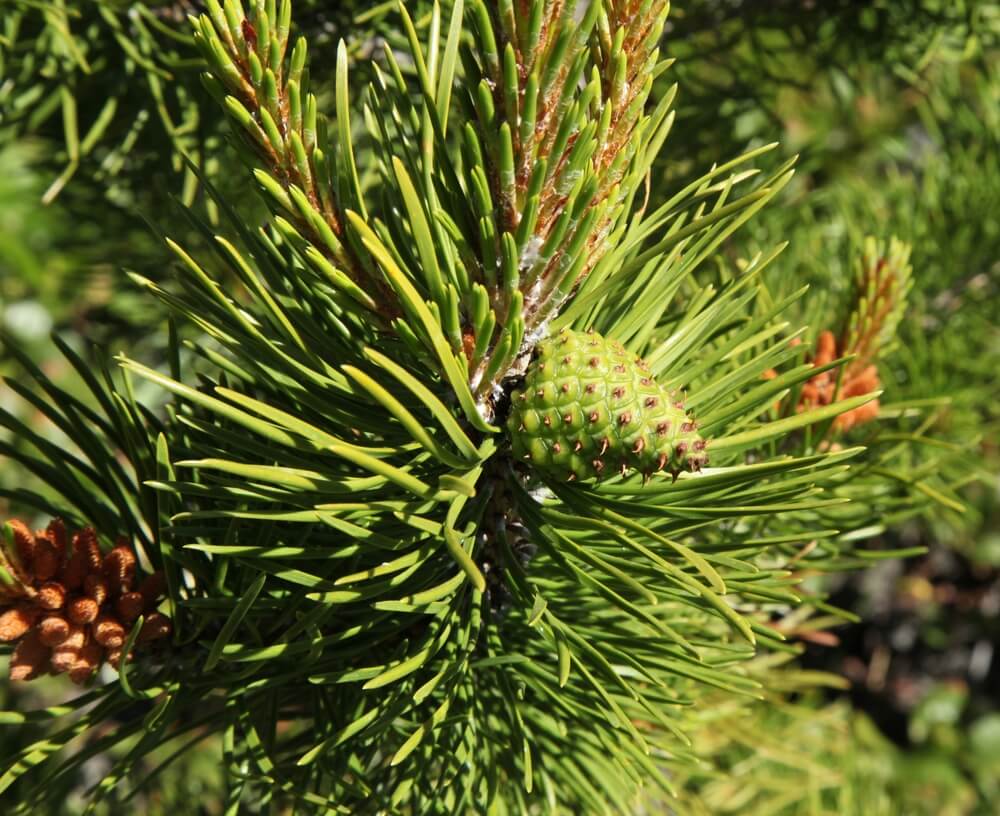
The Lodgepole Pine is a tree with a confusing name! Lodgepole suggests the tree would be tall and straight, but contorta means twisted! So the challenge really comes down to the location of the tree. On the coast, the tree is short and twisted, while inland, the tree is more tall and straight. Regardless, this attractive pine tree can handle a variety of conditions, from windy and rocky to swampy and wet.
It has brown, grooved bark, with groups of 2 yellow-green leaves and egg-shaped cones. Varieties of this tree can grow from zone 3 to 8, from Southern Alaska and Canada, and into California and Colorado. Varieties are either 10 to 32 feet tall or 20 to 164 feet tall and ten to 30 feet wide.
20. Longleaf pine (pinus palustris)
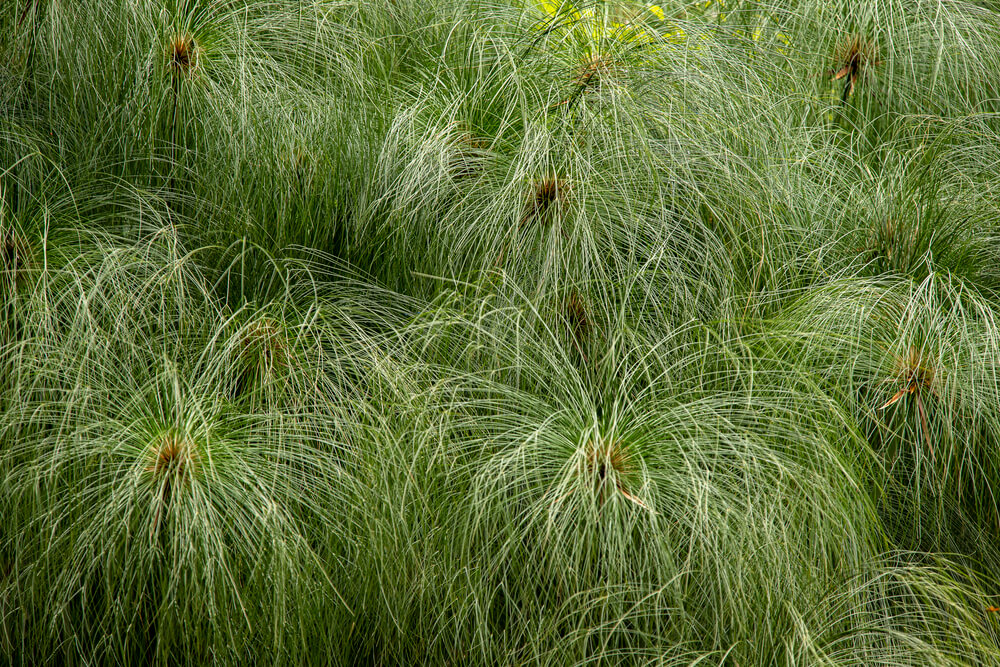
The Longleaf pine gets its name because it has the longest leaves of any pine tree. Its leaves grow in groups of 3, with 8 to 18-inch long yellowish-green leaves and orange-brown bark.
The longleaf pine has a straight trunk with a more rounded crown. It can grow 60 to 100 feet tall with a spread of 20 to 40 feet wide.
Commercially, it is grown for timber and pulp but is also endangered in its natural habitat. It is typically found growing in the Southeast Atlantic States to Florida, in USDA growing zones 7 to
10. However, you may find it as far West as Texas.
21. Mexican Weeping Pine (Pinus patula)
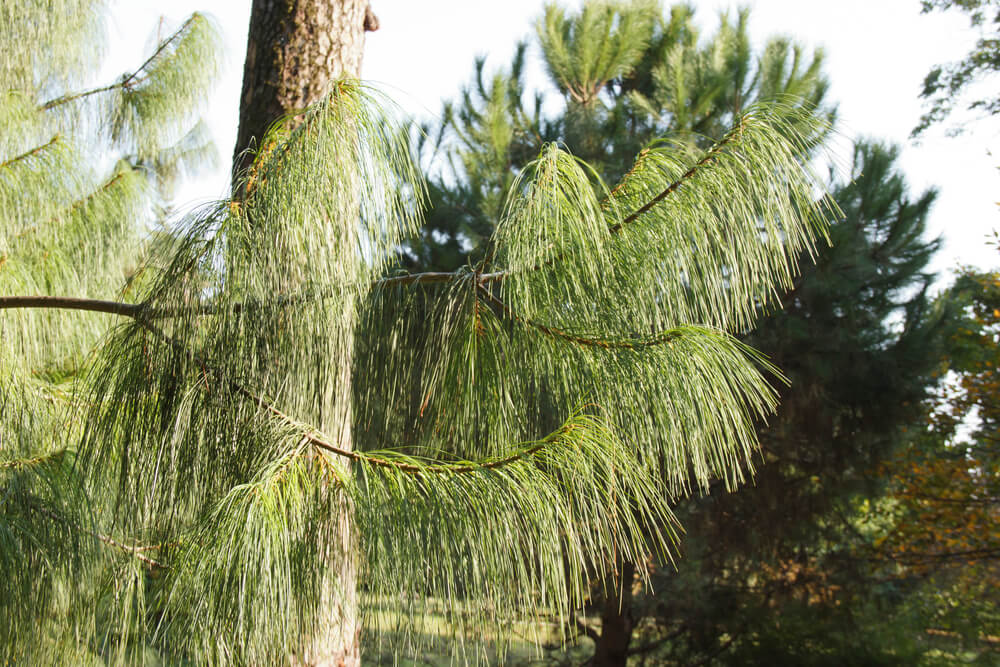
The Mexican Weeping Pine has an elegant appearance, with a tall, straight trunk and drooping tufts of 3 to 4 leaves. The egg-shaped seed cones typically grow in groups of two. The Mexican Weeping Pine is planted as a landscaping tree. However, it can become extremely invasive. It is also used for lumber. It can easily tolerate light shade, and its drooping leaves make it easy to identify.
It can grow as much as 50 to 100 feet tall and 20 to 30 feet wide. It originated in Eastern and Central Mexico and does well in USDA growing zones 8 to 9.
22. Monterey Pine (Pinus radiata)
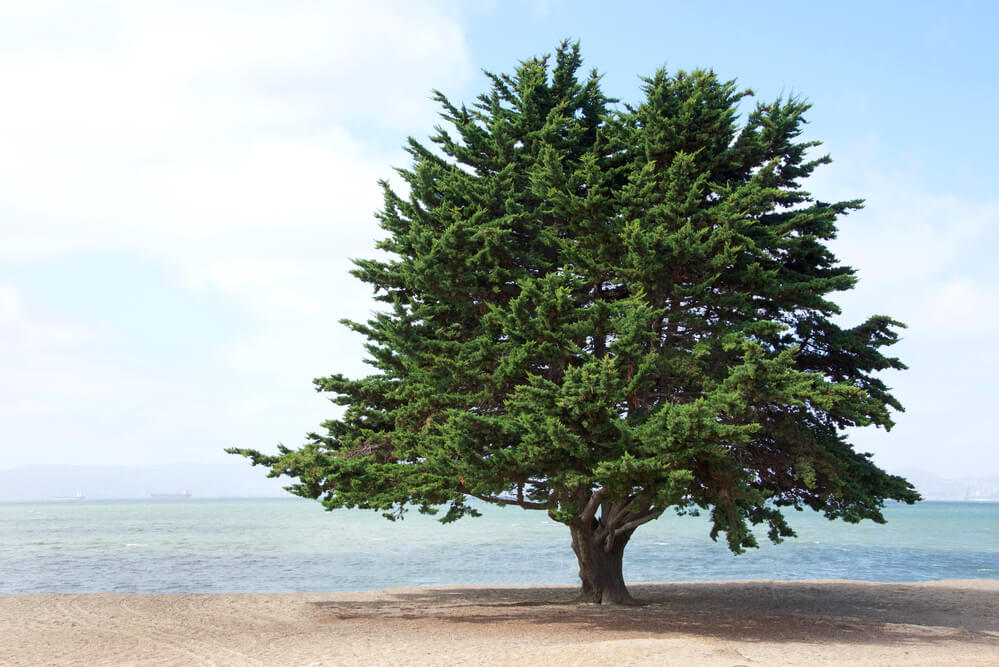
The Monterey Pine is planted for its lumbar and its pulp. However, it is endangered in its natural habitat due to the disease Pine Canker. It is a fast-growing tree and has a thick truck that can grow up to 3 feet in diameter with dark gray bark. The yellow-green leaves generally grow in groups of 2. It will grow up to 50 to 100 feet tall and 25 to 35 feet wide.
The seed cones open with fire and can stay viable for twenty years. They grow in an asymmetric egg shape. It is native to the central coast of California and growing zones 7 to 10.
23. Mugo Pine (Pinus mugo)
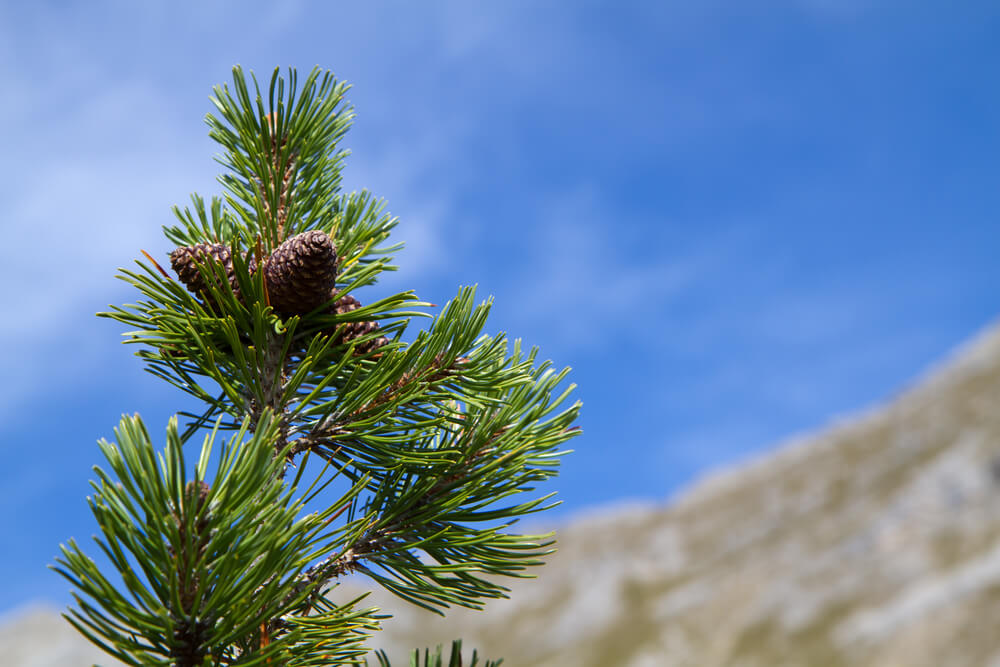
The Mugo Pine is a highly variable species, appearing as a small tree or even a creeping shrub. However, it often grows wider than it is tall, with a height of 5 to 25 feet and a width of 5 to 30 feet. It grows brown-gray bark with two dark green, stiff leaves per cluster.
This unique tree makes an interesting landscaping shrub and can help to curb soil erosion. It prefers sandy soil but can tolerate clay. It usually grows in bogs and just below tree lines.
It originated in the mountains of central and Southern Europe but can grow in USDA, growing zones 2 to 7.
24. Norfolk Island Pine (Araucaria heterophylla)
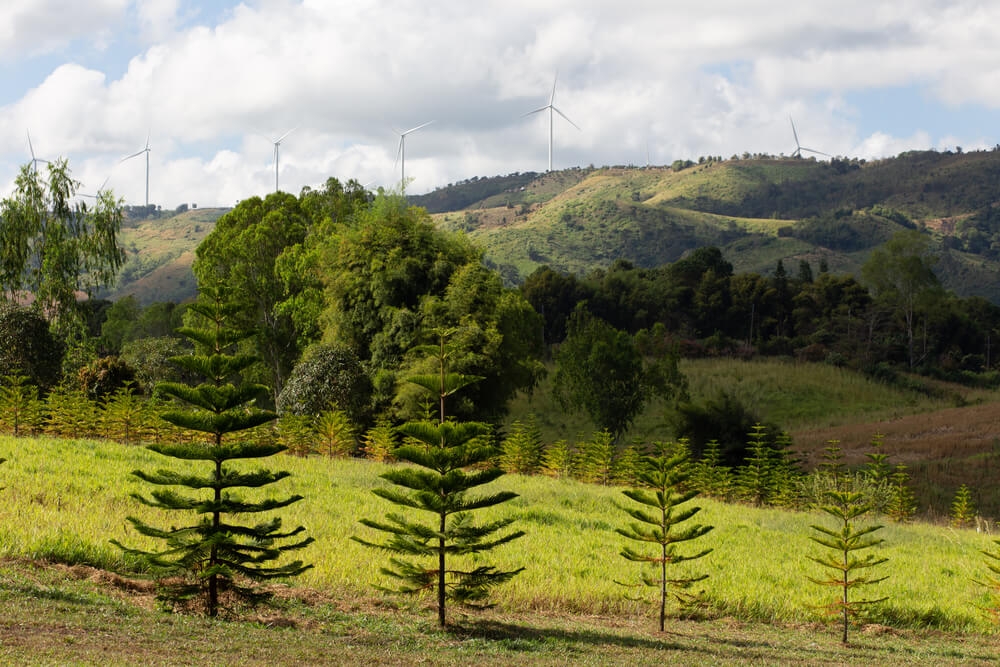
Technically, the Norfolk Island Pine is not a pine tree but a conifer. It has bright green leaves that are only ½ inch long. However, the seed cones can grow to over 4 inches long. It has a straight trunk with dark gray bark.
The Norfolk Island pine makes a great houseplant when it is young. It can do well as a landscape plant if the temperatures don’t go below 30 degrees Fahrenheit.
It is endemic to Norfolk Island and the South Pacific and will only grow in USDA growing zones 9-11. It will grow 60 to 100 feet tall and 12 to 60 feet wide. It will only grow about 5 feet tall and 4 feet wide indoors.
25. Pinyon Pine (Pinus edulis)
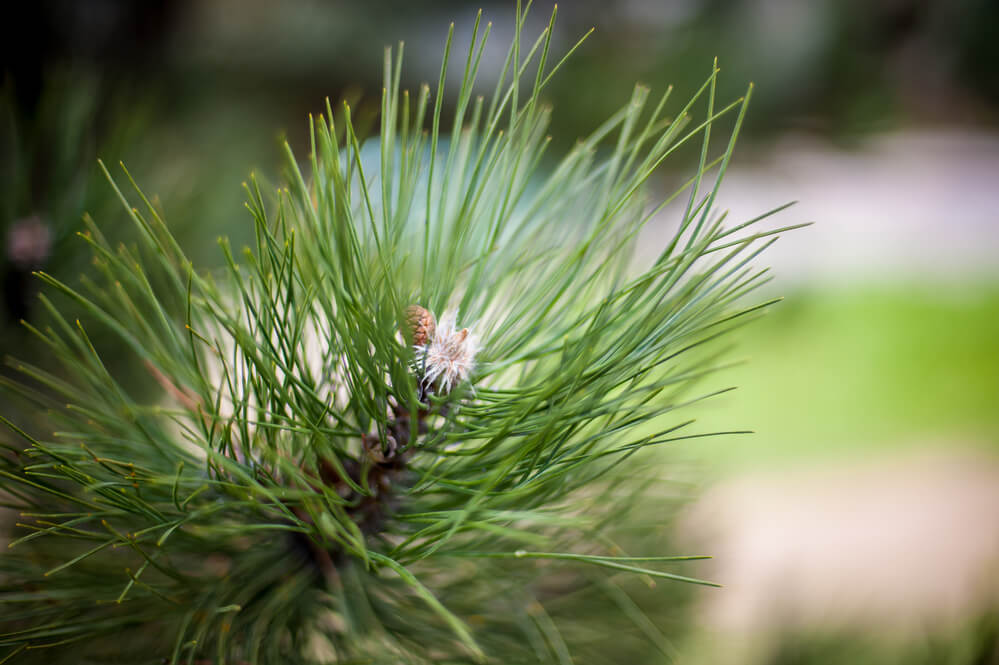
The Pinyon Pine is known for its delicious, edible nuts. It’s a small to medium-sized tree, only growing as tall as 15 to 30 feet high and 15 to 30 feet wide, with red-brown bark that has shallow grooves. The leaves grow in groups of 1 to 3 with a blue-green color. Its cones are egg-shaped and almost round when open.
The Pinyon pine can grow in a variety of soils – even very acidic soil – as long as they are well-draining. You might find it growing with junipers in the southwestern and central united states. It thrives in zones 5 to 8.
26. Pitch Pine (Pinus rigida)
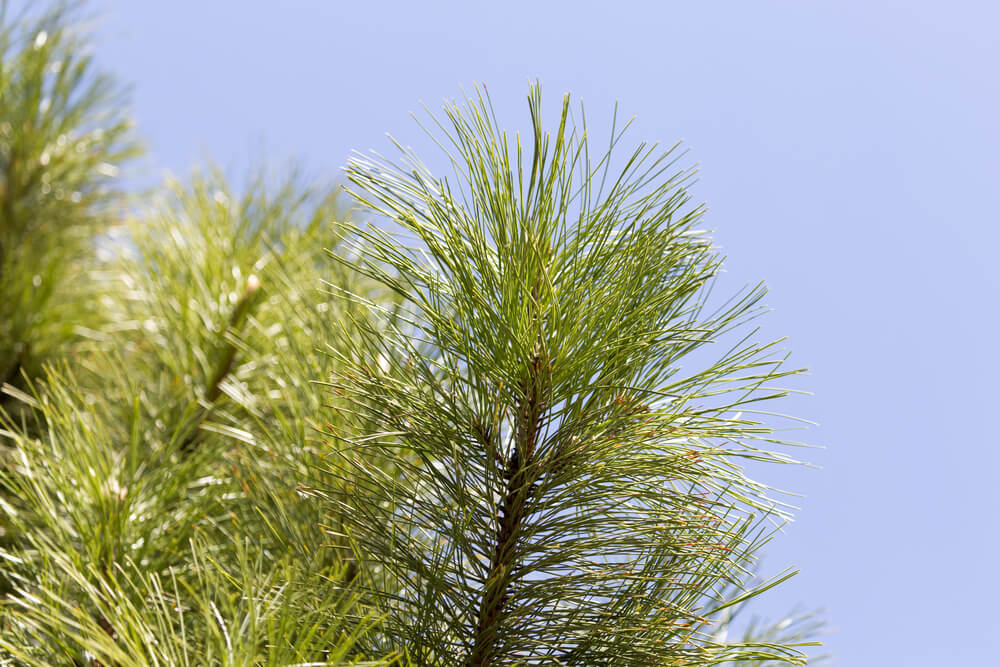
The Pitch pine is a sturdy tree, fire-resistant pine. The trunk can be straight or crooked with a round or irregularly shaped crown. Its yellow-green leaves grow in groups of 3 to 5 and can be 2 to 4 inches long. The egg-shaped seed cones grow in small clusters.
The Pitch pine can also grow in poor soil, whether sandy, acidic, or even low on nutrients. It thrives in growing zones 4 to 7 in eastern North America. It can reach 30 to 100 feet tall at maturity and spread 20 to 50 feet wide.
27. Pond Pine (Pinus serotina)
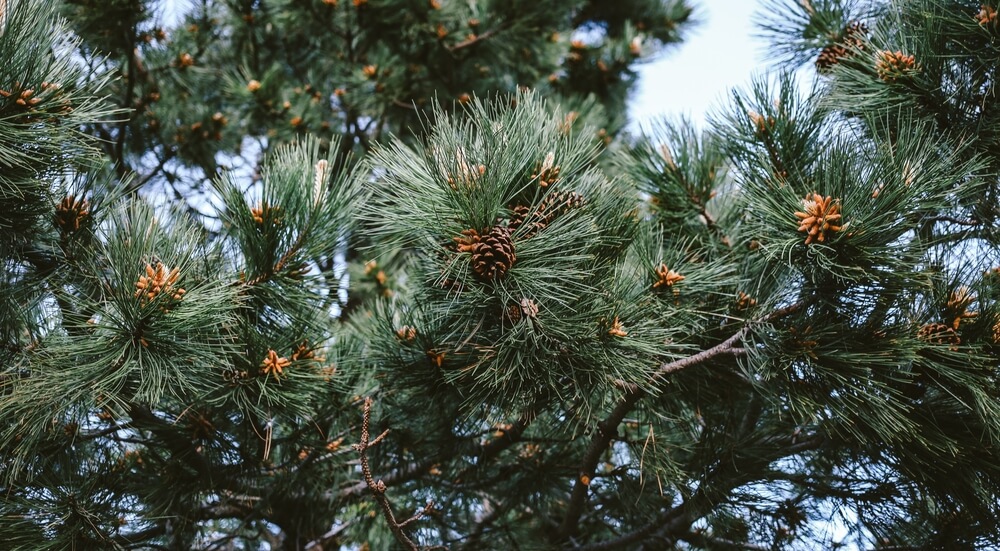
The Pond Pine thrives in wet soils, but its egg-shaped seed cones don’t open until they have been exposed to a forest fire. It has a crooked trunk with grooved, red-brown bark and an irregularly shaped crown.
Its leaves grow in groups of three to five, and it is easily confused with the Loblolly pine. This tree is native to Atlantic USA from New Jersey to Florida and grow zones 7 to 9. At maturity, it can be 30 to 70 feet tall with a spread of 20 to 45 feet wide. However, sometimes, the wet marshy areas where it grows will stunt its growth.
28. Ponderosa Pine (Pinus ponderosa)
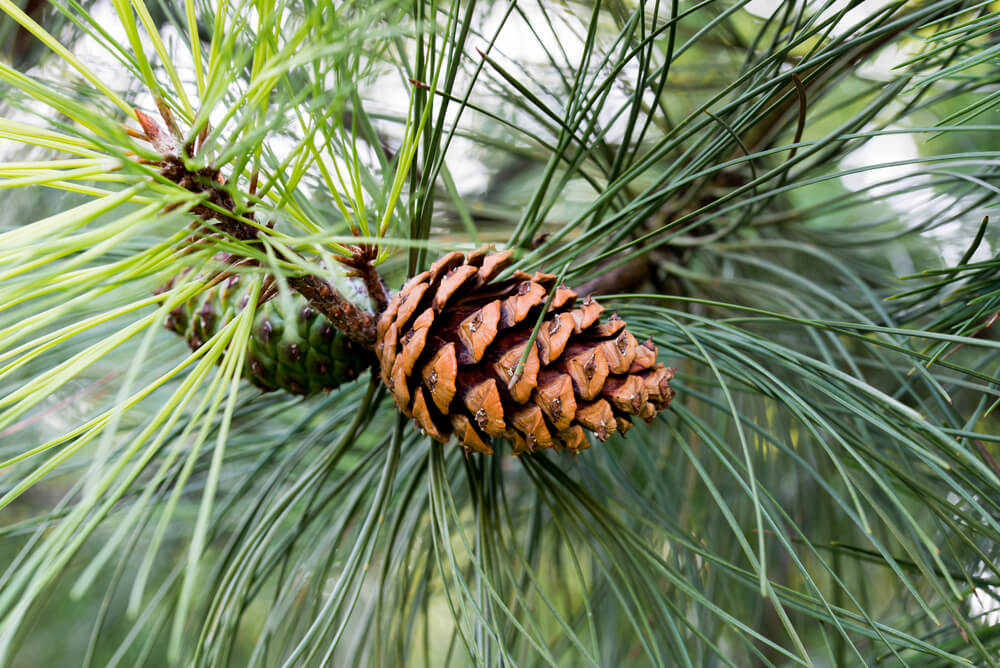
The Ponderosa Pine is typically found in Western North America, growing in USDA grow zones 3 – 8. It’s a tall tree, growing anywhere from 60 to 100 feet tall at maturity, and has a spread of 25 to 30 feet wide. Its leaves grow in groups of 2 to 5, ranging in length from 2 ¾ to 11 ¾ inches long.
The Ponderosa Pine produces egg-shaped cones with triangular points. Its bark is deep brown to black, with irregular grooves. The ponderosa pine is grown for lumbar and its ornamental bark and leaves. The pine needles are a distinctively bright green, which helps distinguish them from other pine trees.
29. Red Pine (Pinus resinosa)
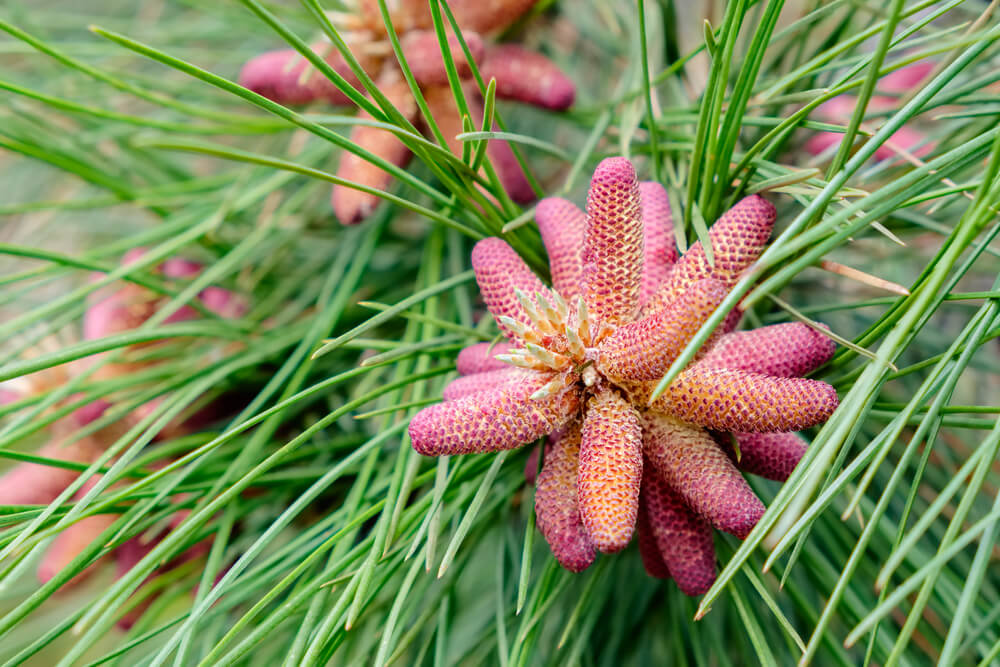
The Red Pine makes an excellent landscape tree, with a tall, straight trunk with grooved, reddish-brown bark. It features a narrow, rounded crown and deep yellow-green leaves that grow in groups of 2. The seed cones are egg-shaped and rounded when open. This tree can grow anywhere from 50 to 80 feet tall at maturity, with a spread between 15 and 30 feet wide.
The Red Pine is very adaptable to a variety of moisture conditions and soil types. It can also self-pollinate. It does not have genetic variation but stays consistent to its type. It can be found from Canada to Pennsylvania and as far west as Minnesota. It grows well in grow zones 3 to 7.
30. Sand Pine (Pinus clausa)
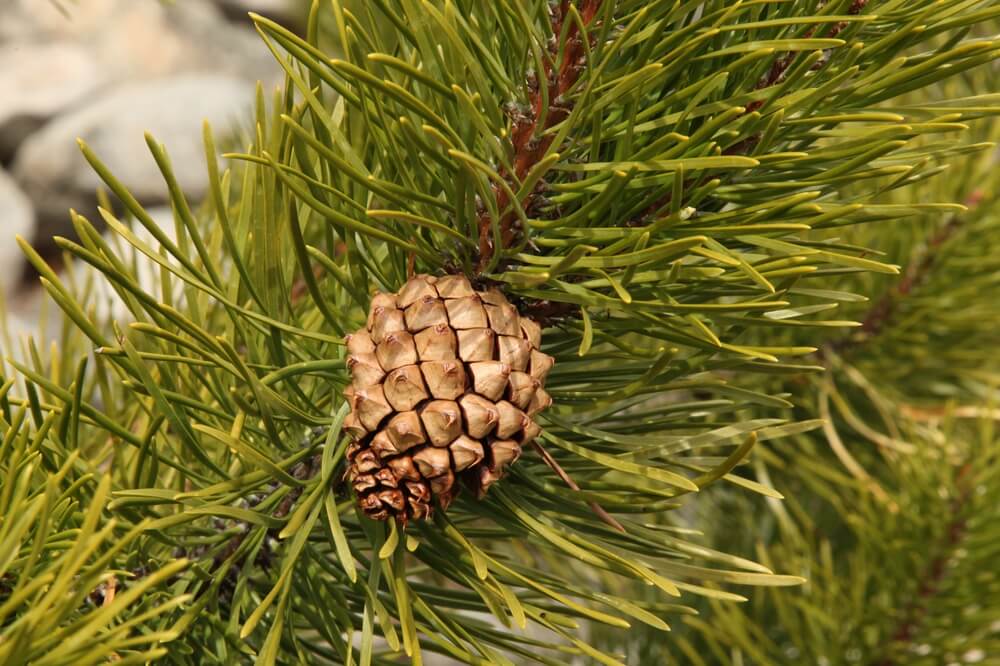
The sand pine is mostly found in the sandy soil of Florida and Alabama. It may have a straight or crooked, leaning trunk with heavy branches and gray bark. Leaves grow in groups of just two and may be 1 to 4 inches long and dark green in color.
The seed cones are egg-shaped but may only open with fire. It can grow well in sandy, acidic soil, and it will even tolerate partial shade. It’s also known as the Spruce Pine and Scrub Pine. It will grow 15 to 60 feet tall and 15 to 25 feet wide in USDA growing zones 7 to 10.
31. Scots Pine (Pinus sylvestris)
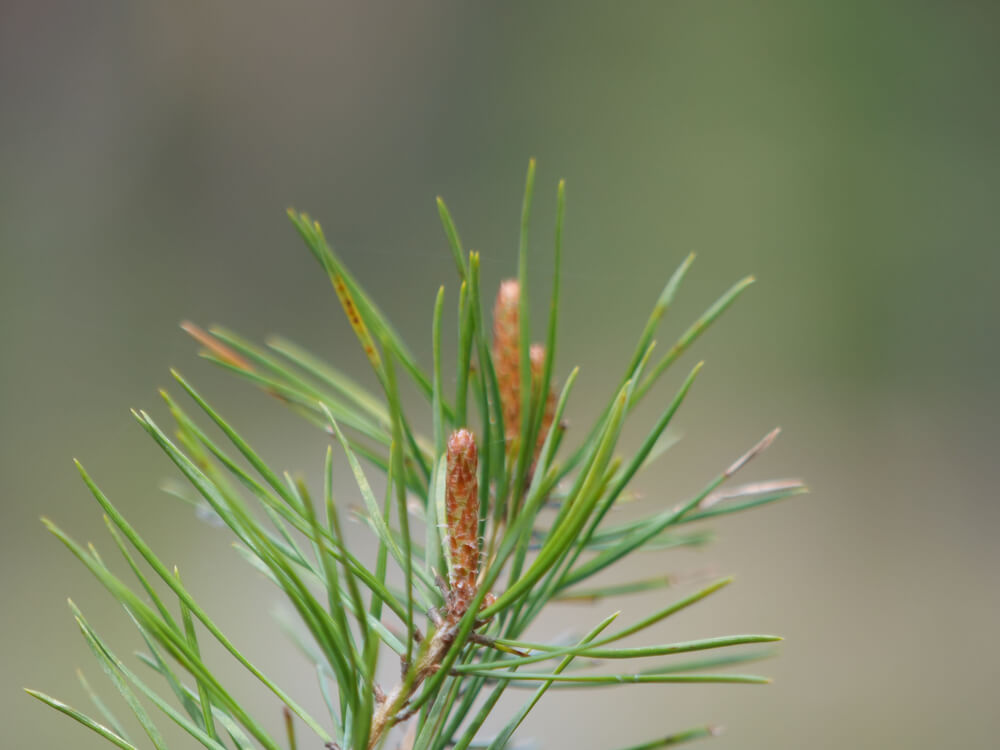
Scots Pines are attractive pine trees that are typically grown for Christmas trees. There are several varieties of Scots pines. They are fast growers and can outpace other plants or nearby trees. It grows easily and has naturalized in the Northern portions of the United States.
It has 1 to 3-inch long, stiff leaves that are blue-green in color. It grows anywhere from 20 to 60 feet tall and 30 to 40 feet wide. Scots pines will grow in USDA grow zones 2 to 7. Although they have naturalized in the United States, these trees originated in Europe and Asia.
32. Shortleaf Pine (Pinuys echinate)
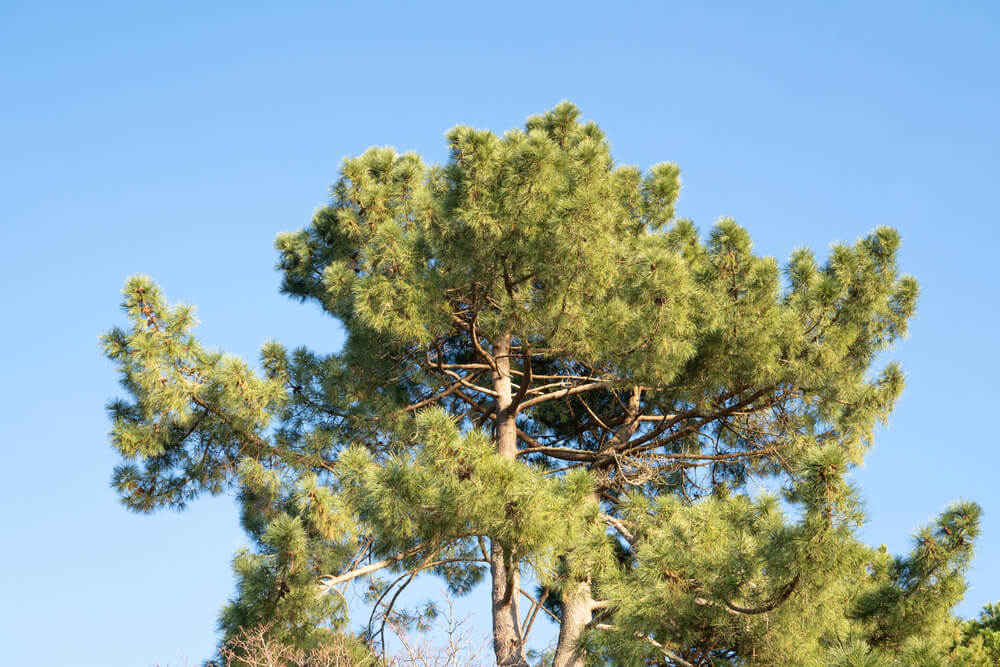
The Shortleaf Pine can withstand some forest fires. It’s often used for its lumber and pulp and in ecological restoration. Old-growth Shortleaf Pines are home to red-cockaded woodpeckers, a federally endangered species.
These pines are tall with straight and wide trunks, growing up to 50 to 80 feet tall and 20 to 35 feet wide. They have red-brown bark with pockets of resin. The leaves grow in groups of 2, up to five inches long.
You’ll find the shortleaf pine in the southeastern United States, from New Jersey to North Florida, in growing zones 6 to 9. It can grow in rocky soil and flood plains in full sun, anywhere from 0 to 3000 feet in elevation.
33. Single Leaf Pinyon Pine (Pinus monophylla)
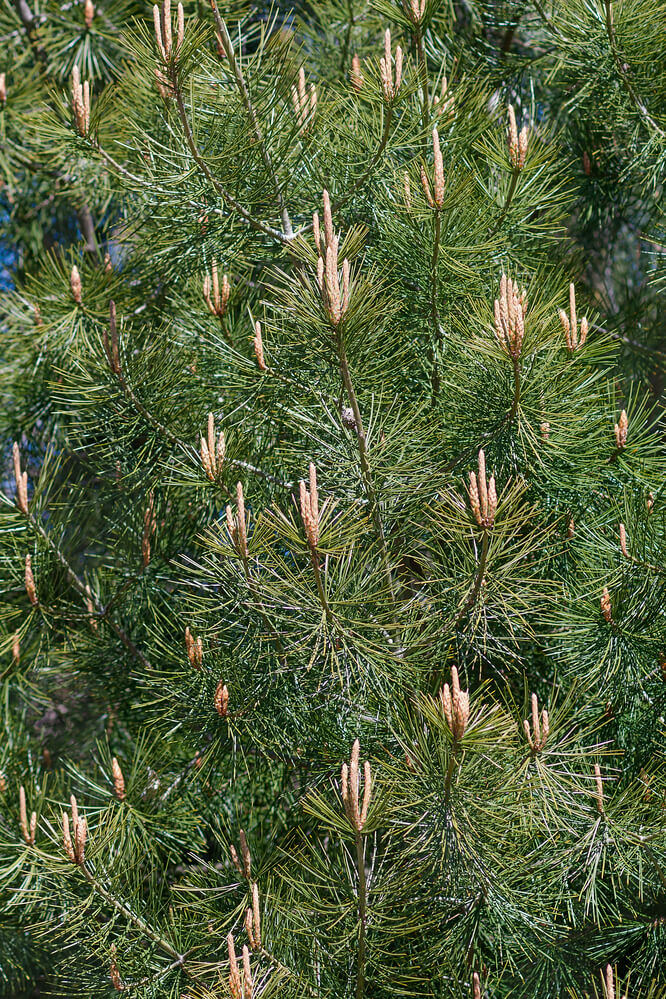
The single-leaf pinyon pine is a smaller tree, only growing 15 to 50 feet tall and 15 to 20 feet wide. It is hard to grow and propagate, so it is rarely if ever, used in landscaping.
What is striking about the single-leaf pinyon pine – and the reason it gets its name – is that it only has a single leaf per fascicle – its leaves don’t grow in clusters, like other pines. This is the only pine tree in the world like this.
Its cones are egg-shaped to round. You’ll find it in Southwestern North America, in growing zones 6 to 8.
34. Sugar pine (Pinus lambertiana)
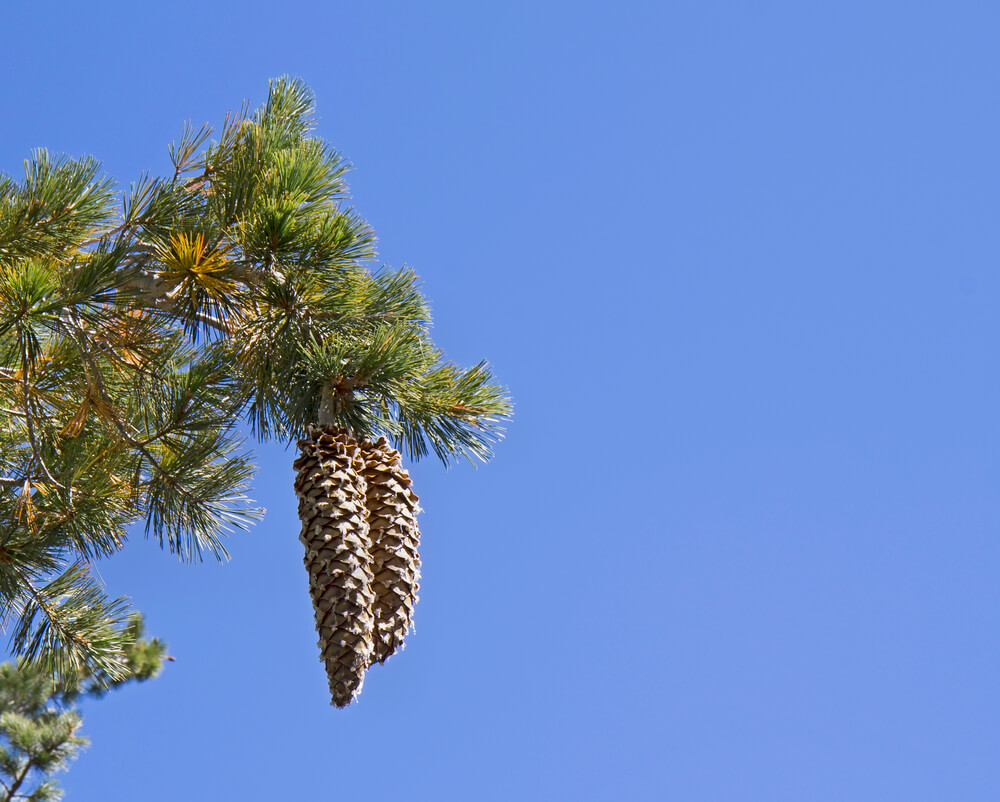
What’s so special about the Sugar Pine? It’s known for being the tallest pine tree! It can grow anywhere from 100 to 200 feet tall and 30 to 50 feet wide. It has a giant trunk that can be over 10 feet wide, and it has the longest pine cones in the world. The cones can grow up to 20 inches long and weigh over 4 pounds each.
The Sugar pine has gray to cinnamon-colored bark with deep grooves. It typically has five leaves per cluster, which are a pretty blue-green color. You’ll find it growing in the mountains of the western United States in growing zones 6 through 9.
35. Torrey Pine (Pinus torreyana)
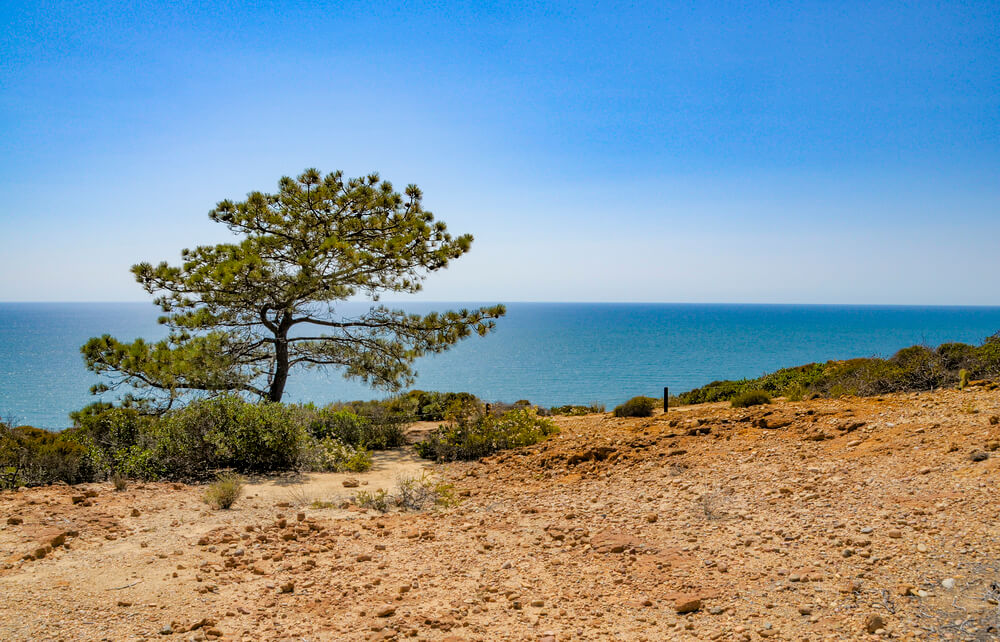
The Torrey Pine is a rare species endemic only to coastal San Diego County and Santa Rosa Island in California. Its trunk is crooked and leaning due to coastal winds, with a round crown. It has showy, purple-red to red-brown bark with deep grooves and ridges. It typically grows 6 to 11-inch long leaves in groups of five. Cones need three years to mature.
The Torrey pine is unique because it is the most rare pine tree in the United States. There are only 4500 Torrey pines in their natural habitat. It only grows in zones 8 to 1 but can reach heights of 25 to 50 feet tall and 25 to 40 feet wide.
36. Turkish Pine (Pinus brutia)
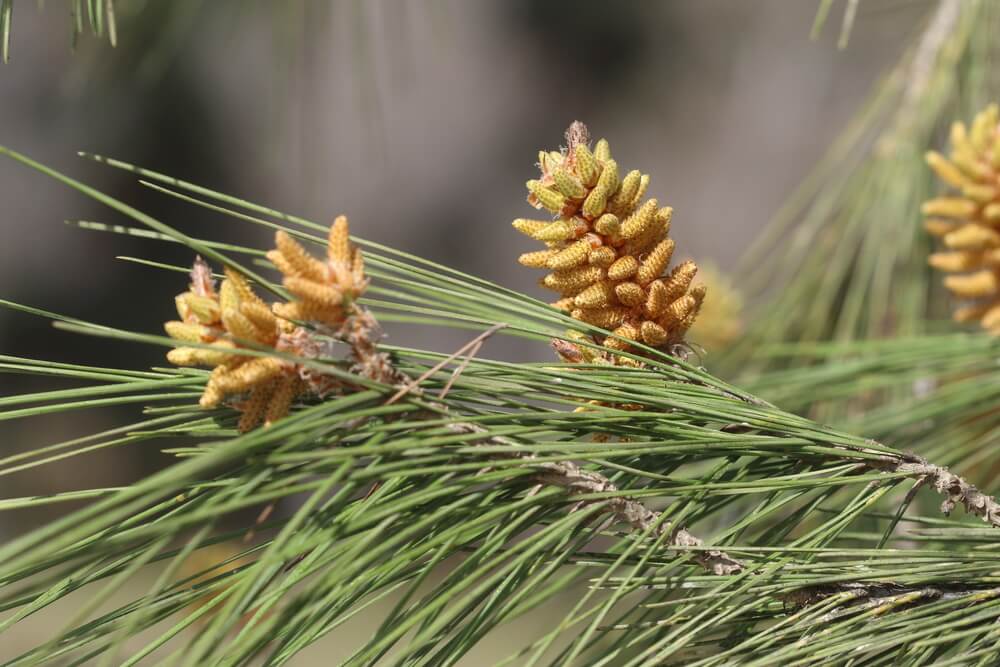
The Turkish pine prefers warmer areas and can be grown in USDA Growing zones 8 to 11. It is not invasive and often used as an ornamental tree in warm climates.
The Turkish pine has a large trunk with orange-red bark that has deep grooves. The bark contrasts beautifully with its yellow-green leaves. The leaves are 4 to 6.5 inches long and grow in small groups of two.
Seed cones start out long but turn egg-shaped as they open. It takes 1 to 2 years for the cones to release their seeds. They can grow anywhere from 30 to 115 feet tall and 20 to 60 feet wide.
37. Virginia Pine (Pinus virginiana)
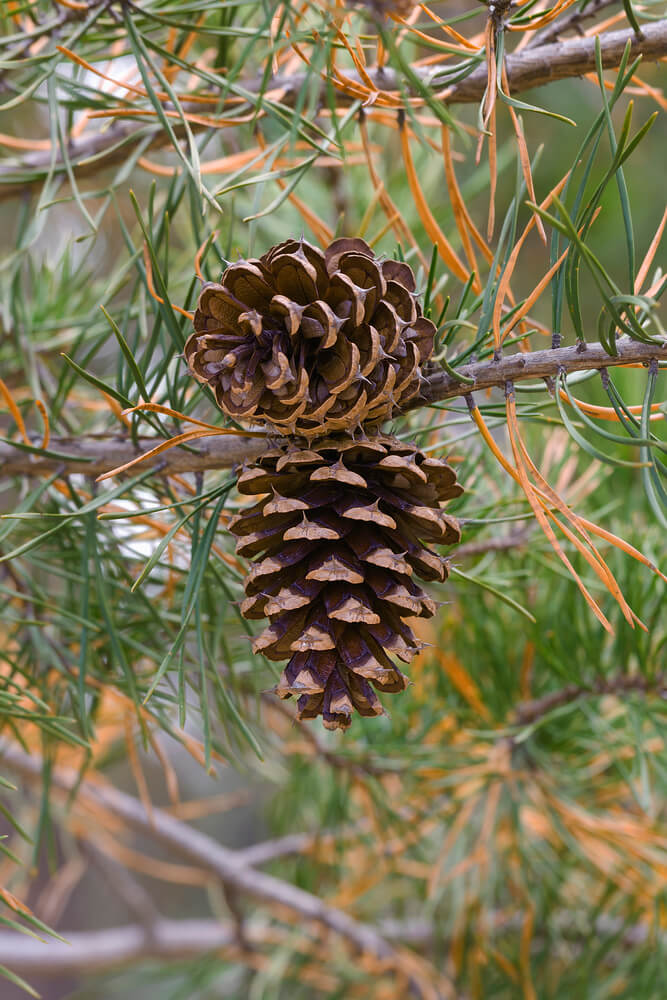
The Virginia Pine, or the Virginia Scrub Pine, has the potential to be an invasive species. It’s also known as the Jersey Pine. It can aggressively repopulate burned-out forests and is capable of self-fertilization.
It is a small to medium-sized tree, growing 50 to 80 feet tall and 20 to 30 feet wide. The trunk can be straight, twisted, or leaning with gray-brown bark. The crown can be flat or irregular. Yellow-green leaves grow in groups of two.
You’ll find it in the Eastern United States from Pennsylvania to Alabama and Georgia, in growing zones 4 to 8.
38. Western White Pine (Pinus monticola)
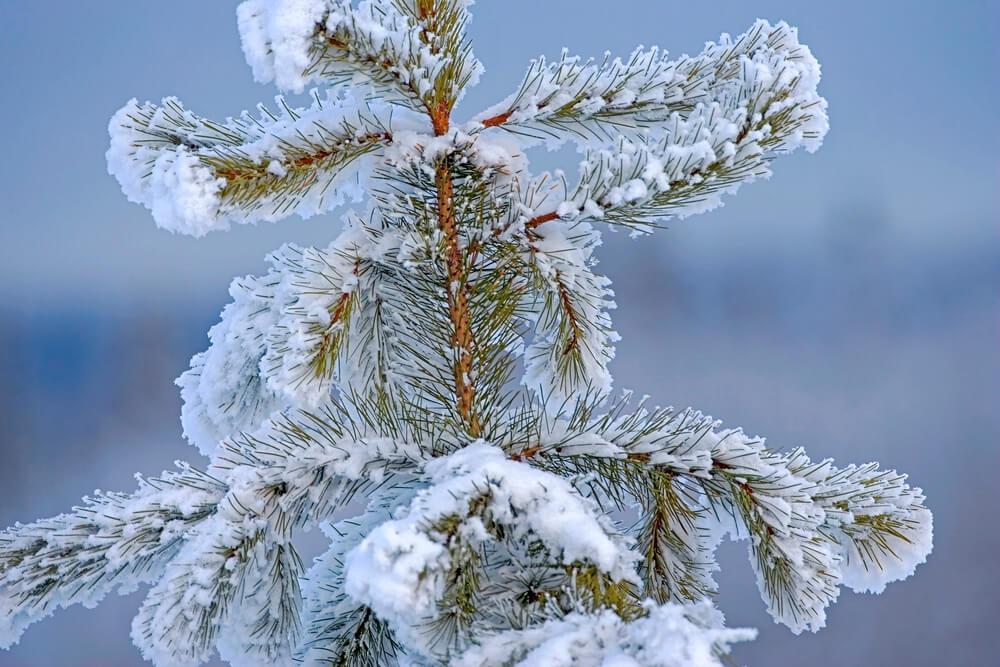
The Western White Pine adorns the mountains of the western United States, growing well in zones 4 through 8. It’s generally a tall, straight tree with grey, scaly bark and a thick trunk. Its silvery-green leaves are soft and grow in groups of 5. Cones grow in clustered groups and can be up to 10 inches long.
It can grow anywhere from 60 to 150 feet tall, with a twenty to thirty-foot spread.
The Western White Pine is nowhere near as common as it used to be due to a fungus that was introduced to the United States from Europe in the early 1900s.
[wp-faq-schema title=”Frequently Asked Questions About Pine Trees” accordion=1]
